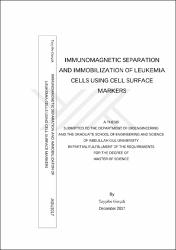Immunomagnetic separation and immobilization of leukemia cells using cell surface markers /
Abstract
Acute Lympoblastic Leukemia, shortly ALL, especially B-precursor Acute Lymphoblastic Leukemia is the most common blood malignancies among childhood cancers. There are different kinds of leukemia treatments but after those therapies, there is likelihood of relapsing the cancer in years because of remained cancer cells in the patient’s body. Nevertheless remained cancer cells in the body after therapy cannot be seen in the routine clinical follow-up tests. Those kind of diseases like leukemia are named as Minimal Residual Disease (MRD). Currently, there are only two ways to detect Minimal Residual Disease. These are flow cytometry and real-time quantified polymerase chain reaction (RQ-PCR). However many different labs have these Flow Cytometry and RQ-PCR, both devices should be calibrated to detect MRD cells. Nowadays there is a consensus about requiring MRD detection but still it is discussed by the authorities about when and how it should be done. The ultimate aim of this project is to produce a chip that can detect MRD cells. With these work we try to capture leukemic cells by using magnetic beads in nano and microsize. These magnetic beads are coated with CD19 and CD45 antibody markers that are in the membrane of leukemia cells. Next step after capturing them with magnetic beads is to immobilize them onto a surface. Golden surfaces are used and functionalized by antibodies. Thus an immunosandwich structure is occured and the cells are immobilized.


















